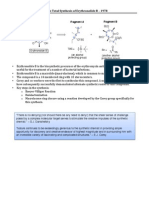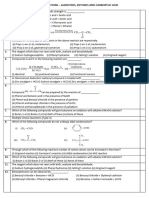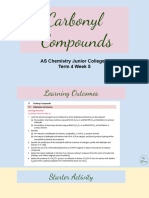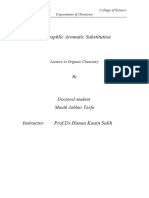Rosenberg 2007
Rosenberg 2007
Uploaded by
Jaydeep MokariyaCopyright:
Available Formats
Rosenberg 2007
Rosenberg 2007
Uploaded by
Jaydeep MokariyaCopyright
Available Formats
Share this document
Did you find this document useful?
Is this content inappropriate?
Copyright:
Available Formats
Rosenberg 2007
Rosenberg 2007
Uploaded by
Jaydeep MokariyaCopyright:
Available Formats
In the Laboratory
A Guided-Inquiry Approach to the Sodium Borohydride W
Reduction and Grignard Reaction of Carbonyl Compounds
Robert E. Rosenberg†
Department of Chemistry and Physics, Salem State College, Salem, MA 01970; rrosenberg@transy.edu
Over the years, numerous articles in this Journal have mechanism). For maximum benefit, this three-period experi-
discussed the advantages of inquiry- or discovery-based labo- ment should commence while studying the addition of nu-
ratories over traditional (cookbook or verification) labs (1). cleophiles to aldehydes and ketones and conclude before the
In short, the two major advantages of the inquiry approach mechanism of nucleophilic addition to carboxylic acid de-
are giving students a sense of excitement and allowing them rivatives is revealed.
to participate in the scientific process. In many cases, these
gains are achieved without sacrificing any of the skills learned Experimental
from the traditional approach. These advantages have led
some programs to incorporate discovery-based laboratories The procedures for NaBH4 reduction (4) and synthesis
into part or all of their laboratory curricula (2). Nonethe- and reaction of phenyl magnesium bromide (5) are adapted
less, most laboratory texts, most second-year organic cur- from standard procedures and are included in the Supple-
ricula, and most organic experiments published in this Journal mental Material.W
feature the traditional approach (3).
In this work, the guided-inquiry approach is applied to Hazards
two standard experiments from the second semester of or-
ganic chemistry: sodium borohydride reduction of a ketone Methanol and sodium borohydride are both highly flam-
and the Grignard addition of phenyl magnesium bromide to mable and toxic. Bromobenzene is an irritant. Magnesium is
a carbonyl compound (Table 1). Each student works in a team flammable. The unknowns are either irritants (benzoic an-
of four and performs these two reactions on an unknown car- hydride, benzophenone) or harmful (benzaldehyde). Ether
bonyl compound from the following list of possible un- is harmful and extremely flammable. Hydrochloric acid is
knowns: benzaldehyde, benzophenone, benzoic anhydride, corrosive. Students should have adequate eye protection, wear
and ethyl benzoate.1 IR spectral and melting point data of gloves, and work in a well ventilated space at all times dur-
the reaction products are used to establish both product and ing both of these procedures.
starting material identities. Students use their team data to
draw conclusions about relative reactivity (esters are the least Discussion
electrophilic species of the four carbonyl compounds stud-
ied, the Grignard reagent is more nucleophilic than NaBH4) NaBH4 Reduction
and about reaction mechanism (carboxylic acid derivatives The first week of the experiment involves the NaBH4 re-
undergo substitution reactions via an addition–elimination duction of an unknown. After the reaction, students will iden-
†
Current address: Department of Chemistry, Transylvania Uni- tify their unknown by using (i) the physical state of their
versity, Lexington, KY 40508. unknowns at ambient temperature, (ii) IR spectra and melt-
Table 1. Unknowns and Their Potential Reaction Products
Substitution +
Entry Unknown No Reaction Addition Substitution
Addition
Reaction with NaBH4
1 PhCHO(l) –– PhCH2OH(l) –– ––
2 Ph2CO(s) –– Ph2CHOH(s) –– ––
3 PhCO2Et(l) PhCO2Et(l) PhCH(OH)OEt PhCHO PhCH2OH
4 (PhCO)2O(s) (PhCO)2O PhCH(OH)OBz PhCHO PhCH2OH(l)
Reaction with PhMgBr
5 PhCHO –– Ph2CHOH(s) –– ––
6 Ph2CO –– Ph3COH(s) –– ––
7 PhCO2Et PhCO2Et Ph2C(OH)OEt Ph2CO Ph3COH(s)
8 (PhCO)2O (PhCO)2O Ph2C(OH)OBz Ph2CO Ph3COH(s)
Abbreviations: Ph = phenyl = C6H5; Et = ethyl = CH3CH2; Bz = benzoyl = C6H5CO. For reactions of PhCO2Et and
(PhCO)2O, the actual product is underlined.
1474 Journal of Chemical Education • Vol. 84 No. 9 September 2007 • www.JCE.DivCHED.org
In the Laboratory
ing point data of their products, and (iii) an instructor-pro-
vided list of possible products, shown in Table 1. The reac-
tion products for the aldehyde and ketone are given explicitly,
(entries 1 and 2). A series of four possible reaction outcomes
are given for the carboxylic acid derivatives, (entries 3 and 4).
Students use physical data to divide their unknowns into
a liquid group (benzaldehyde and ethyl benzoate) and a solid
group (benzophenone and benzoic anhydride), (decision 1 in
Figure 1). In the liquid group, the product of benzaldehyde
reduction is given as benzyl alcohol and is uniquely identi-
fied by the OH stretch in its IR spectrum, (analysis I, Figure
1). By elimination, ethyl benzoate is identified as the other
liquid unknown. Now, the reduction product of ethyl ben-
zoate must be identified from the four possibilities shown in
entry 3 of the table. This product has an IR spectrum with a
C⫽O stretch but not an OH stretch consistent with either
starting material or benzaldehyde (analysis II, Figure 1). This
choice can be resolved (i) by logic (benzaldehyde is known to
react with NaBH4), (ii) by smell (the product does not smell
like benzaldehyde), or (iii) by taking an IR spectrum of ei-
ther ethyl benzoate or benzaldehyde (analysis III, Figure 1).
In the solid group, the product of benzophenone reduc-
tion is given as benzhydrol, which is uniquely identified by
its melting point (analysis IV, Figure 1). By elimination, ben-
zoic anhydride is identified as the other solid unknown. Now,
the reduction product of benzoic anhydride must be identi-
fied from the four possibilities in entry 4 of Table 1. This
product must be benzyl alcohol as it is the only potential
product with an IR spectrum that has an OH stretch but
not a C⫽O stretch (analysis V, Figure 1).
With a list of known starting materials and products in
hand, students can make two conclusions about reactivity.
First, esters are the least electrophilic compounds in this set
since they do not react under these conditions. Second, car-
boxylic acid derivatives react differently than aldehydes and
ketones: they do not give addition products. Instructors in-
terested in a one-week experiment could stop at this point.
Grignard Reaction
The next two weeks involve the addition of the carbo-
nyl compounds to phenyl magnesium bromide. With the
identities of the unknown determined from the NaBH4 re-
action, students only need to identify the Grignard products.
The given products of benzaldehyde (benzhydrol, entry 5 in
Table 1) and benzophenone (triphenylmethanol, entry 6 in
Table 1) are verified by their melting points. For each of the
Figure 1. Guide to the analysis of unknown identities and reaction
two carboxylic acid derivatives, there are four possible reac- products for NaBH4 reduction.
tion outcomes, listed as entries 7 and 8 in Table 1. Both prod-
ucts are identified as triphenylmethanol as their melting
points match the benzophenone product.
Looking at both data sets, students can conclude that
Grignard reagents are stronger nucleophiles than NaBH4 since
only the Grignard reagent gives a product with esters. With group of the carboxylic acid derivative. Substitution can oc-
some leading questions, students can use the product data cur in three ways: (i) simultaneously, (ii) elimination followed
from the two reactions to propose a reasonable mechanism by addition, or by (iii) addition followed by elimination. Since
for the addition of strong nucleophiles to carboxylic acid de- the Grignard reagent undergoes addition to aldehydes and
rivatives. Since the ketone, ester, and anhydride all give the ketones, it is reasonable to assume that Grignard reagents also
same Grignard product, it is reasonable (though not neces- initially add to carboxylic acid derivatives. This fits best with
sary) to assume that all three compounds proceed through a an addition–elimination mechanism. Similar reasoning can
common intermediate, the ketone. For this to occur, the phe- be used to rationalize the product formed in the addition of
nyl group of the Grignard reagent must substitute for the X hydride to benzoic anhydride.2
www.JCE.DivCHED.org • Vol. 84 No. 9 September 2007 • Journal of Chemical Education 1475
In the Laboratory
Conclusion Notes
Using standard experiments (NaBH4 reduction and re- 1. Many lab sizes will mandate some teams of three, in which
action of a Grignard reaagent), students learn about the re- case the instructor can provide data on the fourth compound.
activity and mechanism of carbonyl compounds. For 2. This argument is probably better suited to a class or team
reactivity, they discover that esters are less reactive electro- discussion than as a postlab question.
philic than ketones, aldehydes, or anhydrides and that Grig-
nard reagents are more nucleophilic than NaBH 4 . Literature Cited
Mechanistically, students learn that carboxylic acid deriva-
tives do not yield simple addition reactions with nucleophiles. 1. (a) Monteyne, K.; Cracolice, M. S. J. Chem. Educ. 2004, 81,
With a little help, students can be led to the correct mecha- 1559–1560. (b) Mohrig, J. R. J. Chem. Educ. 2004, 81, 1083–
nism. 1084. (c) Allen, J. B.; Barker, L. N.; Ramsden, J. H. J. Chem.
Educ. 1986, 63, 533–534. (d) Wartell, M. A. J. Chem. Educ.
Acknowledgments 1973, 50, 361–362.
2. Jarrett, R. M.; McMaster, P. D. J. Chem. Educ. 1994, 71,
The author would like to thank the students of Salem 1029–1031.
State College for helping to test these ideas. Also, the author 3. Horowitz, G. J. Chem. Educ. 2003, 80, 1039.
would like to thank David K. Johnson (SUNY, Geneseo) and 4. Bell, C. E., Jr.; Taber, D. F.; Clark, A. K. Organic Chemistry
Irvin J. Levy (Gordon College) for their shared wisdom. Laboratory, 3rd ed.; Harcourt College Publishing: New York,
2001; p 216.
W
Supplemental Material 5. (a) Williamson, K. L. Organic Experiments, 4th ed.; Houghton
Mifflin Co.: Boston, 2003; pp 465–470, 472–476. (b)
Instructions for the students, including prelab work and Mohrig, J. R.; Hammond, C. N.; Morrill, T. C.; Neckers, D.
report sheets, and notes for the instructor are available in this C. Experimental Organic Chemistry, 1st ed.; W. H. Freeman
issue of JCE Online. and Co.: New York, 1998; pp 122–126.
1476 Journal of Chemical Education • Vol. 84 No. 9 September 2007 • www.JCE.DivCHED.org
You might also like
- 4-Bromobenzophenone by Friedel-Craft ReactionDocument11 pages4-Bromobenzophenone by Friedel-Craft Reactionohhi100% (1)
- Synthesis of Phenobarbital, An Anticonvulsant DrugDocument8 pagesSynthesis of Phenobarbital, An Anticonvulsant DrugAntonio Cortez D Lara XDNo ratings yet
- Chapter 16: Benzene - Electrophilic Aromatic Substitution: Chem231 Study Notes On McmurryDocument20 pagesChapter 16: Benzene - Electrophilic Aromatic Substitution: Chem231 Study Notes On McmurrykjjkimkmkNo ratings yet
- Solomon's Chapter 15 SolutionDocument34 pagesSolomon's Chapter 15 SolutionRobert0% (2)
- Corey's Total Synthesis of Erythronolide B - 1978Document3 pagesCorey's Total Synthesis of Erythronolide B - 1978Mathias PradoNo ratings yet
- Phase Transfer Catalyzed Selective Reduction of Bifunctional MoietiesDocument6 pagesPhase Transfer Catalyzed Selective Reduction of Bifunctional MoietieschemistryjournalNo ratings yet
- Department of PG Studies in Chemistry Government Science College (Autonomous) HassanDocument8 pagesDepartment of PG Studies in Chemistry Government Science College (Autonomous) Hassanmadhukh06No ratings yet
- R. Jason Herr - A Whirlwind Tour of Current Mitsunobu ChemistryDocument36 pagesR. Jason Herr - A Whirlwind Tour of Current Mitsunobu ChemistryRoundSTICNo ratings yet
- Pereaksi GrignardDocument8 pagesPereaksi Grignardisya_nurhidaNo ratings yet
- Revision Questions Ald, Ket - CacidDocument3 pagesRevision Questions Ald, Ket - Cacidmail.gagan2025No ratings yet
- Experiment 1. Ketone Reduction by Sodium Borohydride: Butyrophenone and AcetophenoneDocument3 pagesExperiment 1. Ketone Reduction by Sodium Borohydride: Butyrophenone and AcetophenoneHawra JawadNo ratings yet
- tổng hợp nghịchDocument81 pagestổng hợp nghịchruakon_ldt9527100% (1)
- Arkivoc 2017, V, 314-326Document13 pagesArkivoc 2017, V, 314-326RohanNo ratings yet
- Topic Exploration Pack Reactions of Phenols: Instructions and Answers For TeachersDocument31 pagesTopic Exploration Pack Reactions of Phenols: Instructions and Answers For TeachersCamille deanNo ratings yet
- Assignment 4 Reactions of Aromatic Compounds AnswersDocument11 pagesAssignment 4 Reactions of Aromatic Compounds AnswersJonathan Yeung100% (1)
- Exp 2Document11 pagesExp 2ohhiNo ratings yet
- Exp07 Stereochem Camphor NewDocument4 pagesExp07 Stereochem Camphor NewNefliNo ratings yet
- Sodium Borohydride in Carboxylic Acid MediaDocument10 pagesSodium Borohydride in Carboxylic Acid MediadntwntNo ratings yet
- Síntesis de Calix (4) PirrolDocument5 pagesSíntesis de Calix (4) PirrolFelipe De Gante100% (1)
- 20 Reactions ChemistryDocument7 pages20 Reactions ChemistryEsteban VargasNo ratings yet
- Active Methylene Compounds1-S2.0-S0040402012007971-MainDocument6 pagesActive Methylene Compounds1-S2.0-S0040402012007971-MainSeren ModNo ratings yet
- Reacciones Caracteristicas Por Grupos FuncionalesDocument3 pagesReacciones Caracteristicas Por Grupos FuncionalesAdelitza StrubingerNo ratings yet
- Chemistry Organic FlowchartsDocument3 pagesChemistry Organic FlowchartsLouisefleming0% (1)
- Carbonyl GroupDocument32 pagesCarbonyl GroupYan Xin LuNo ratings yet
- Intramolecular Acylation of Aryl - and Aroyl-Aliphatic Acids by The Action of Pyrophosphoryl Chloride and Phosphorus OxychlorideDocument8 pagesIntramolecular Acylation of Aryl - and Aroyl-Aliphatic Acids by The Action of Pyrophosphoryl Chloride and Phosphorus OxychlorideChiến NguyễnNo ratings yet
- Unit 4Document14 pagesUnit 4a49502462No ratings yet
- Tetrahedron Letters 52 (2011) 5107-5109Document3 pagesTetrahedron Letters 52 (2011) 5107-5109rajesh_tammana3550No ratings yet
- Chapter 12 Aldehydes, Ketones and Carboxylic AcidsDocument46 pagesChapter 12 Aldehydes, Ketones and Carboxylic Acidsabi shinNo ratings yet
- Radical-Mediated Bromination of Carbohydrate Derivatives: Searching For Alternative Reaction Conditions Without Carbon TetrachlorideDocument4 pagesRadical-Mediated Bromination of Carbohydrate Derivatives: Searching For Alternative Reaction Conditions Without Carbon TetrachlorideBalaji ChandrasekharNo ratings yet
- Decarboxylative Alkynylation and Carbonylative Alkynylation of Carboxylic Acids Enabled by Visible Light Photoredox Catalysis - CompressDocument4 pagesDecarboxylative Alkynylation and Carbonylative Alkynylation of Carboxylic Acids Enabled by Visible Light Photoredox Catalysis - CompressshankhadeepawsNo ratings yet
- Hem Actsheet: Organic Chemistry 4: Carbonyl CompoundsDocument3 pagesHem Actsheet: Organic Chemistry 4: Carbonyl CompoundsDaniel C. WalshNo ratings yet
- AldehydesDocument5 pagesAldehydeslove.mansijhaNo ratings yet
- Alcohol Inversion: Beyond The MitsunobuDocument4 pagesAlcohol Inversion: Beyond The MitsunobudoubleffectNo ratings yet
- Heterocyclic Chemistry Guidance Note and ProblemsDocument13 pagesHeterocyclic Chemistry Guidance Note and ProblemsGhadeer M HassanNo ratings yet
- Ol 0265867Document3 pagesOl 0265867hiyarkalita123No ratings yet
- 12-Aliphatic Nucleophilic Substitution PDFDocument68 pages12-Aliphatic Nucleophilic Substitution PDFVenkatraj Gowdas100% (1)
- CHM 102Document50 pagesCHM 102ugradus.eduNo ratings yet
- 1 Ketone Reduce F 09Document3 pages1 Ketone Reduce F 09Tok WanNo ratings yet
- AlcoholDocument7 pagesAlcoholabhale.dhruvaNo ratings yet
- Aromatic C CDocument8 pagesAromatic C CBhuvnesh singhNo ratings yet
- Chalcone Deivative Synthesis 2Document7 pagesChalcone Deivative Synthesis 2Ankit Kumar SinghNo ratings yet
- Postlab8 9Document3 pagesPostlab8 9Niño Sandro Jocson MercadoNo ratings yet
- An Unusual Dehalogenation in The Suzuki Coupling of 4-Bromopyrrole-2-CarboxylatesDocument4 pagesAn Unusual Dehalogenation in The Suzuki Coupling of 4-Bromopyrrole-2-CarboxylatesAkshita GuptaNo ratings yet
- Topic 5Document30 pagesTopic 5Shehnaz KamarNo ratings yet
- Organic Chemistry II The Report of PracticumDocument8 pagesOrganic Chemistry II The Report of PracticumpranggajatiNo ratings yet
- Chalcone in MicrowaveDocument5 pagesChalcone in MicrowaveFatema HussainNo ratings yet
- CHEM 2425 Review For Test 4 - Chapter 22 - 23 - 24 - 230115 - 183827Document21 pagesCHEM 2425 Review For Test 4 - Chapter 22 - 23 - 24 - 230115 - 183827mahdi aliNo ratings yet
- Wittig Reaction SibiDocument4 pagesWittig Reaction SibivinaybharadwajbsNo ratings yet
- Grade Xii (Chemistry) : Aldehydes, Ketones and Carboxylic Acids (Term - 2) : Most Expecting QuestionsDocument5 pagesGrade Xii (Chemistry) : Aldehydes, Ketones and Carboxylic Acids (Term - 2) : Most Expecting QuestionsSupreeta KhatiwadaNo ratings yet
- CM134-1L Experiment 2.3Document8 pagesCM134-1L Experiment 2.3Christian JohnNo ratings yet
- Aromatic Amines As Nucleophiles in The Bargellini Reaction PDFDocument4 pagesAromatic Amines As Nucleophiles in The Bargellini Reaction PDFdavidNo ratings yet
- Multi-Step Organic SynthesisDocument6 pagesMulti-Step Organic SynthesisPhạm Thị Thùy NhiênNo ratings yet
- Siegel Hydroxyl at I OnDocument5 pagesSiegel Hydroxyl at I OncorechiNo ratings yet
- Wittigr Reaction SYNT 721Document12 pagesWittigr Reaction SYNT 721Betty Weiss100% (1)
- Exp 11 - Aldol CondensationDocument3 pagesExp 11 - Aldol CondensationJustin BayneNo ratings yet
- The Total Synthesis of Natural ProductsFrom EverandThe Total Synthesis of Natural ProductsJohn ApSimonNo ratings yet
- Efficiency in Natural Product Total SynthesisFrom EverandEfficiency in Natural Product Total SynthesisPei-Qiang HuangNo ratings yet
- Sustainable synthesis of ciclopentene derivatives through multicomponent reactions in continuous flow regimeFrom EverandSustainable synthesis of ciclopentene derivatives through multicomponent reactions in continuous flow regimeNo ratings yet
- Practice Makes Perfect in Chemistry: Organic ChemistryFrom EverandPractice Makes Perfect in Chemistry: Organic ChemistryRating: 3 out of 5 stars3/5 (1)
- Iridium Complexes in Organic SynthesisFrom EverandIridium Complexes in Organic SynthesisLuis A. OroNo ratings yet
- CHT Reviewer OChem 5Document112 pagesCHT Reviewer OChem 5Chastine CruzNo ratings yet
- IB Chemistry SL - 2025 Questionbank - Electron-pair Sharing ReactionsDocument9 pagesIB Chemistry SL - 2025 Questionbank - Electron-pair Sharing ReactionskininkjNo ratings yet
- 1-M.Sc. (Previous) Chemistry Syllabus and Model Papers 2021-2022Document32 pages1-M.Sc. (Previous) Chemistry Syllabus and Model Papers 2021-2022Balakrishna GantaNo ratings yet
- MCAT Organic Summary SheetDocument6 pagesMCAT Organic Summary SheetSpencer Thomas100% (2)
- Full download Organic reactions and their mechanisms 3 ed Third Edition Kalsi P.S. pdf docxDocument75 pagesFull download Organic reactions and their mechanisms 3 ed Third Edition Kalsi P.S. pdf docxishaniadonel5100% (4)
- Chap 16 (Notes)Document134 pagesChap 16 (Notes)Steffi YapNo ratings yet
- Nucleophlic Aromatic SubstitutionDocument10 pagesNucleophlic Aromatic SubstitutionHalala HajiNo ratings yet
- Org Chem Module ADocument21 pagesOrg Chem Module ATootsie YeollieNo ratings yet
- 2013 SP 12 Chemistry 06Document6 pages2013 SP 12 Chemistry 06ashrafraziNo ratings yet
- Nucleophile PDFDocument31 pagesNucleophile PDFShrikantSaxenaNo ratings yet
- Notes On Preparation of HaloalkanesDocument18 pagesNotes On Preparation of Haloalkanesranjana roy100% (1)
- Buy ebook Microscale and Miniscale Organic Chemistry Laboratory Experiments 2 ed 2nd Edition Schoffstall Allen M. cheap priceDocument64 pagesBuy ebook Microscale and Miniscale Organic Chemistry Laboratory Experiments 2 ed 2nd Edition Schoffstall Allen M. cheap priceadzicmcginn100% (7)
- Hsa Physical - ScienceDocument4 pagesHsa Physical - Scienceidrees mohammedNo ratings yet
- 2021 2022 Organic Chemistry I Elimination ReactionsDocument28 pages2021 2022 Organic Chemistry I Elimination ReactionsAhmed ZakyNo ratings yet
- Chem 31 Prob Set Org Mech NucleophilicDocument3 pagesChem 31 Prob Set Org Mech NucleophilicJolaine ValloNo ratings yet
- Syn and Anti Isomer Preference in Oximes: An Undergraduate Organic Chemistry ExperimentDocument3 pagesSyn and Anti Isomer Preference in Oximes: An Undergraduate Organic Chemistry ExperimentJonathanNo ratings yet
- Organic Chemistry Test 1Document12 pagesOrganic Chemistry Test 1DenisNo ratings yet
- Rxns of Aromatic AminesDocument34 pagesRxns of Aromatic AminesDivyansh Nagar100% (1)
- Weekly Test-25 Sankalp2325s1, T1 & P1 Paper & Answer Key (Xii)Document16 pagesWeekly Test-25 Sankalp2325s1, T1 & P1 Paper & Answer Key (Xii)agnit.dgNo ratings yet
- Recognizing Endo and Exo - Master Organic ChemistryDocument9 pagesRecognizing Endo and Exo - Master Organic ChemistryashishNo ratings yet
- Sylabas With Model Paper PDFDocument36 pagesSylabas With Model Paper PDFRavi KumarNo ratings yet
- Chapter 1 - Nomenclature - Reaction Classification 2Document55 pagesChapter 1 - Nomenclature - Reaction Classification 2Duong Hoang Thoai ChauNo ratings yet
- Unit 10 Alkyl HalideDocument6 pagesUnit 10 Alkyl HalideDeepesh kumarNo ratings yet
- Reactions of Aromatic CompoundsDocument39 pagesReactions of Aromatic CompoundsAgita RakaNo ratings yet
- New Age' Caatalogue PDFDocument25 pagesNew Age' Caatalogue PDFajitphadkuleNo ratings yet
- Lecture Plan For Jee - Chemistry (2021) S. No. Chapter Name Topics Name No. of Lecture Date of LectureDocument6 pagesLecture Plan For Jee - Chemistry (2021) S. No. Chapter Name Topics Name No. of Lecture Date of LectureSurendra SinghNo ratings yet
- Organic Chemistry Lab ManualDocument80 pagesOrganic Chemistry Lab ManualImane MAMINo ratings yet
- Reaction Flashcards (Substitution and Elimination) PDFDocument5 pagesReaction Flashcards (Substitution and Elimination) PDFArjun GandotraNo ratings yet

























































































